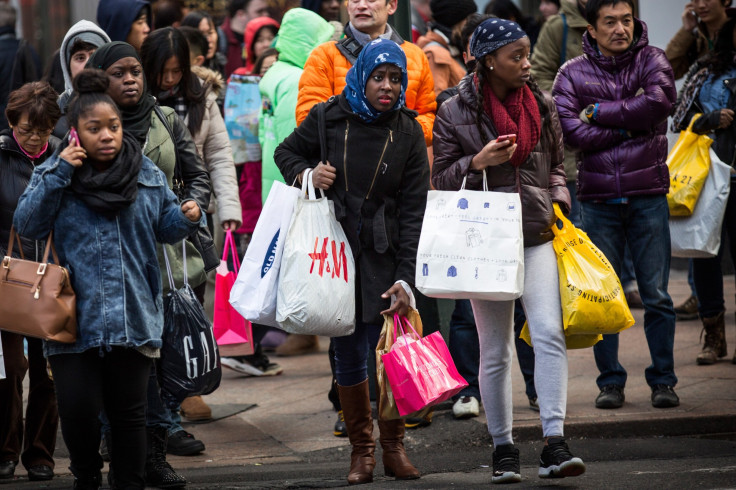Weak US Retail Sales Suggest Moderate Q4 Economic Growth

WASHINGTON (Reuters) -- U.S. retail sales rose less than expected in October amid a surprise decline in automobile purchases, suggesting a slowdown in consumer spending that could temper expectations of a strong pickup in fourth-quarter economic growth.
Other data on Friday showed a second straight monthly decline in producer prices as the cost of services fell. Still, the soft inflation and signs of slowing consumer spending are unlikely to deter the Federal Reserve from raising interest rates next month, economists said.
"The weak reports will provide some cause for caution at the Fed, and while they are unlikely to change the prevailing bias for a December 'liftoff,' they could add to the case for a shallower tightening path thereafter," said Millan Mulraine, deputy chief economist at TD Securities in New York.
The Commerce Department said retail sales edged up 0.1 percent last month after being unchanged in both September and August. Economists had forecast sales increasing 0.3 percent.
Sales at auto dealerships fell 0.5 percent last month after rising 1.4 percent in September. The decline was surprising given that automakers reported strong sales for October. Economists said heavy discounting to attract buyers was likely to blame for the discrepancy.
A 0.9 percent drop in the value of sales at service stations, which reflected lower gasoline prices, also helped to restrain retail sales last month.
Retail sales excluding automobiles, gasoline, building materials and food services rose 0.2 percent after a 0.1 percent gain in September. These so-called core retail sales correspond most closely with the consumer spending component of gross domestic product.
The lackluster report suggests that savings from cheaper gasoline are being used to pay rents, which have increased substantially over the past year.
Barclays trimmed its fourth-quarter GDP estimate by one-tenth of a percentage point to a 2.4 percent annual rate. The weak October retail sales also could raise concerns about the upcoming holiday shopping season.
RELATED COVERAGE
› U.S. business inventories rise; third-quarter growth likely to be raised
Economists, however, are optimistic of sturdy consumer spending in the final months of the year, as a pickup in job growth and low inflation boost disposable income.
CONSUMERS UPBEAT
That view was supported by a separate report showing the University of Michigan's consumer sentiment index rose to 93.1 in early November from a reading of 90.0 in October.
The survey showed an improvement in buying plans for large discretionary purchases, especially vehicles. Lower-income households also were upbeat about their prospects in November.
"The rise in confidence to the level last seen in July might ease a few concerns at the Fed about slowing growth in recent months," said John Ryding, chief economist at RDQ Economics in New York.
A third report from the Labor Department showed its producer price index fell 0.4 percent last month after dropping 0.5 percent in September.
In the 12 months through October, the PPI fell 1.6 percent, the largest decline since the revamped series started in 2009 and following on the heels of a 1.1 percent drop in September. October also marked the ninth straight 12-month decrease in the index.
The weak spending and inflation data did not significantly shift expectations the Fed will raise rates next month in the wake of October's robust employment report.
RELATED COVERAGE
› U.S. economy seen expanding 2.3 percent in fourth-quarter: Atlanta Fed
U.S. rates futures implied that traders saw a 66 percent chance of a rate hike in December, compared to 70 percent on Thursday, according to CME Group's FedWatch. The U.S. central bank has kept its benchmark overnight interest rate near zero since December 2008.
The Standard & Poor's retail index .SPXRT fell 2.28 percent, underperforming an overall weak U.S. stock market. Retailer Macys' (M.N) dropped 2.5 percent and department store operator Kohls (KSS.N) declined 6.5 percent.
Prices of U.S. Treasuries were trading higher and the dollar rose against a basket of currencies.
Economic growth braked to a 1.5 percent rate in the third quarter as businesses worked through an inventory glut and energy companies continued to cut back spending in response to lower oil prices.
But a fourth report from the Commerce Department suggested the drag on third-quarter growth from inventories was probably not as large as initially thought. Retail inventories excluding autos, which go into the GDP calculation, increased 0.5 percent in September after a similar rise in August.
With a report earlier this week showing a solid rise in wholesale inventories in September, JPMorgan said it expected third-quarter GDP would be raised to a 2.3 percent rate when the government publishes its revision later this month.
That, however, means inventories would again weigh on growth in the fourth quarter.
(Reporting by Lucia Mutikani; Editing by Paul Simao)
© Copyright Thomson Reuters 2024. All rights reserved.











